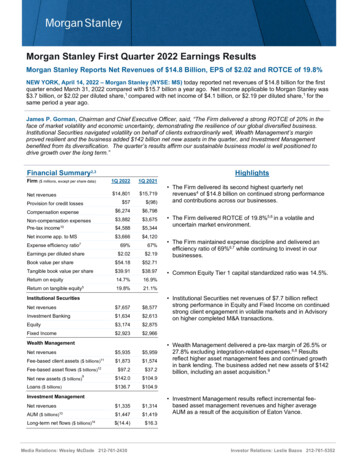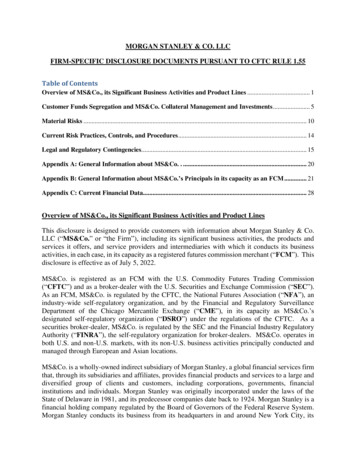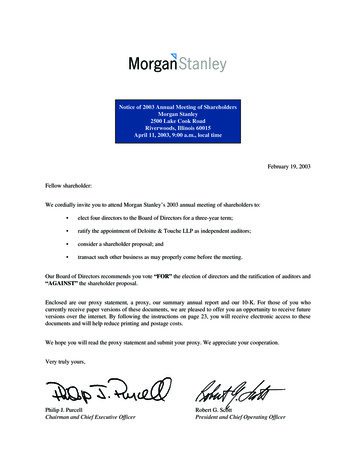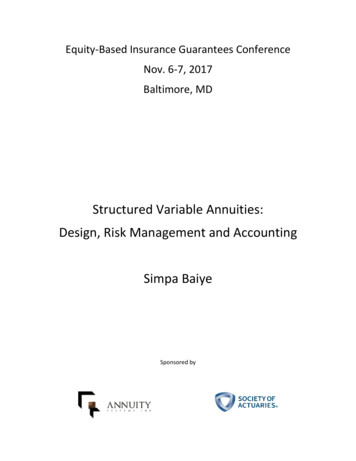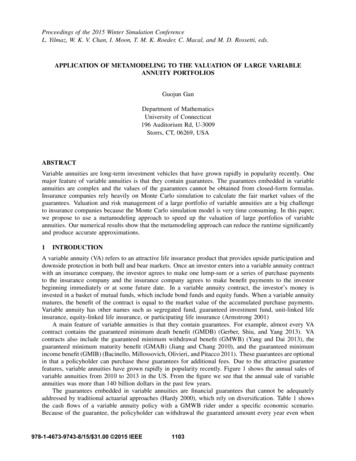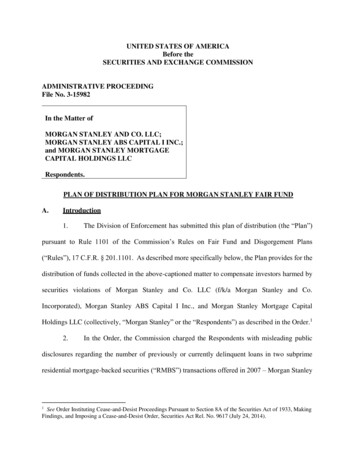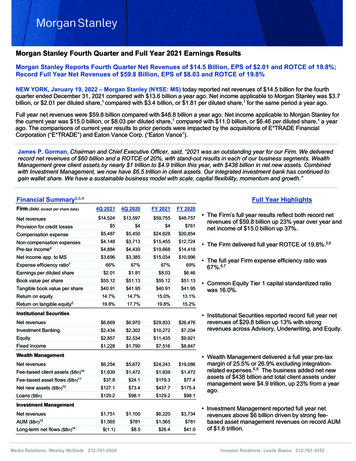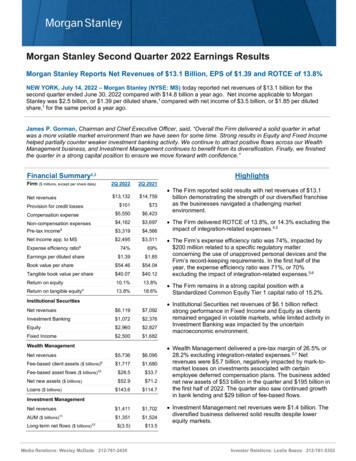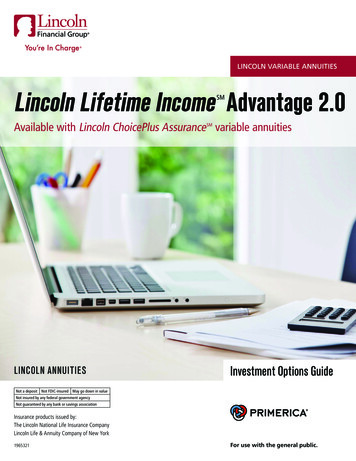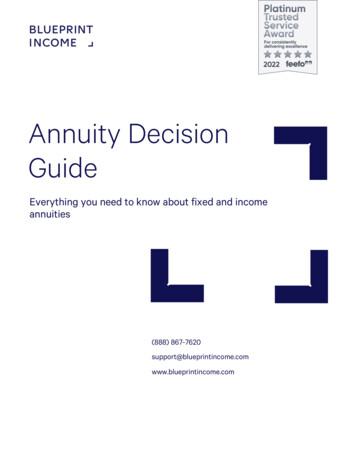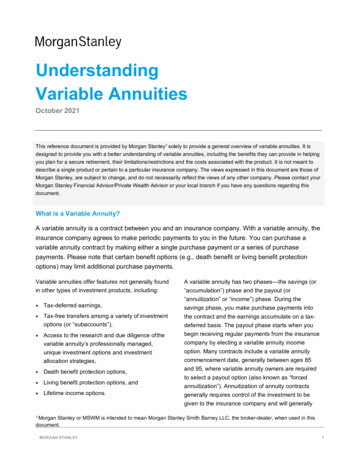
Transcription
UnderstandingVariable AnnuitiesOctober 2021This reference document is provided by Morgan Stanley1 solely to provide a general overview of variable annuities. It isdesigned to provide you with a better understanding of variable annuities, including the benefits they can provide in helpingyou plan for a secure retirement, their limitations/restrictions and the costs associated with the product. It is not meant todescribe a single product or pertain to a particular insurance company. The views expressed in this document are those ofMorgan Stanley, are subject to change, and do not necessarily reflect the views of any other company. Please contact yourMorgan Stanley Financial Advisor/Private Wealth Advisor or your local branch if you have any questions regarding thisdocument.What is a Variable Annuity?A variable annuity is a contract between you and an insurance company. With a variable annuity, theinsurance company agrees to make periodic payments to you in the future. You can purchase avariable annuity contract by making either a single purchase payment or a series of purchasepayments. Please note that certain benefit options (e.g., death benefit or living benefit protectionoptions) may limit additional purchase payments.Variable annuities offer features not generally foundin other types of investment products, including: Tax-deferred earnings,A variable annuity has two phases—the savings (or“accumulation”) phase and the payout (or“annuitization” or “income”) phase. During thesavings phase, you make purchase payments into Tax-free transfers among a variety of investmentoptions (or “subaccounts”),the contract and the earnings accumulate on a taxdeferred basis. The payout phase starts when you Access to the research and due diligence of thevariable annuity’s professionally managed,unique investment options and investmentallocation strategies,begin receiving regular payments from the insurancecompany by electing a variable annuity income Death benefit protection options, Living benefit protection options, and Lifetime income options.option. Many contracts include a variable annuitycommencement date, generally between ages 85and 95, where variable annuity owners are requiredto select a payout option (also known as “forcedannuitization”). Annuitization of annuity contractsgenerally requires control of the investment to begiven to the insurance company and will generallyMorgan Stanley or MSWM is intended to mean Morgan Stanley Smith Barney LLC, the broker-dealer, when used in thisdocument.1MORGAN STANLEY1
terminate any living or death benefits provided in thecontract.Why Consider a Variable Annuity?A variable annuity is a long-term investmentprimarily designed for retirement or anotherlong-range goal. As noted above, a variable annuitylets you accumulate assets on a tax-deferred basis.If you are looking to supplement other sources ofretirement income—such as Social Security andpension plans—you may want to consider a variableannuity.When considering the purchase of a variableannuity, numerous factors should be taken intoaccount including, but not limited to, your: Age, Annual income, Financial situation and needs,downturns. Before buying any variable annuity, youshould request a prospectus from your FinancialAdvisor/Private Wealth Advisor and read it carefully.The prospectus contains important information aboutthe variable annuity contract including fees andcharges, investment options and objectives, risks,death benefits, living benefits and variable annuityincome options. All of these should be consideredcarefully. You should compare the benefits andcosts of the variable annuity you are considering toother variable annuities and to other types ofinvestments before investing.Annuities in Investment Advisory/WrapFee AccountsVariable annuities may be purchased in either abrokerage account or in a Morgan StanleyConsulting Group Advisor investment advisoryaccount. For an explanation of the differences Investment experience and investment objectivesbetween a brokerage and investment advisoryrelationship, please review “Client Relationship Preferred engagement model (Brokerage orAdvisory)Summary ,” which is available athttps://www.morganstanleyclientserv.com/publicco Intended use for the variable annuity (e.g., toleave assets to beneficiaries, to receive incomefor life, tax deferred investments, etc.), Investment time horizon, Existing assets including investment and lifeinsurance holdings, Liquidity needs (see the section titled “ShareClass and Surrender Periods” for moreinformation), Liquid net worth, Net worth, Tolerance for risk, and Tax status.Please note that variable annuities involveinvestment risk and a variable annuity may losevalue. Therefore, you should consider your ability tosustain investment losses during periods of marketMORGAN f .Please see the Consulting Group Advisor Form ADVBrochure for information about that investmentadvisory account. You may also request a copy ofthese documents from your Morgan Stanley team.“Free Look” PeriodVariable annuities typically have a trial period of 10or more days from your receipt of the contract. Thisis known as the “free look” period. During this time,you can terminate the contract and get back yourpurchase payments without paying any surrendercharges. The purchase payments may be adjustedto reflect charges and the performance of thesubaccounts you selected. You are encouraged toask questions before the “free look” period ends tomake sure you understand your variable annuity andconfirm that it is right for you.2
Variable Annuity Fees and ChargesThere are fees and charges that are unique to variableannuity products. These fees and charges cover thecost of contract administration, distribution, portfolio(or investment) management and the insurancebenefits (e.g., death and living benefit protectionoptions, lifetime income options).Because fees and charges may be assessed on theoriginal investment, the current account value or thebenefit’s base value (or “benefit base”), you shouldbecome familiar with all types of fees and charges,and the methodology for their calculation within theparticular variable annuity you are purchasing. The Contract Maintenance Fee (or “Annual Fee”):The contract maintenance fee is an annual flat feecharged for record keeping and administrativepurposes. The fee typically ranges from 30 to 50 and is deducted on the contract anniversary.This fee is typically waived for contract values over 50,000. Underlying Subaccount Fees andExpenses: Fees and expenses are alsocharged on the subaccounts. These includemanagement fees that are paid to theinvestment adviser responsible for makinginvestment decisions affecting yoursubaccounts. This is similar to the investmentmost common fees and charges are:manager’s fee in a mutual fund. Expensesinclude the costs of buying and selling Mortality and Expense Risk Charge (M&E): TheM&E charge compensates the insurance companysecurities as well as administering trades.These asset-based expenses will vary byfor insurance risks and other costs it assumesunder the variable annuity contract. M&E charges3.26% annually.are deducted from the value of the subaccounts(i.e., the investment options you select). The feesfor any optional death and/or living benefit youmay select are described below and are notincluded in the M&E charge. M&E charges areassessed daily and typically range from 0.20% to1.80% annually. Administrative and Distribution Fees: Thesefees cover the costs associated with servicingand distributing the variable annuity. These feesinclude the costs of transferring funds betweensubaccounts, tracking purchase payments,issuing confirmations and statements as well asongoing customer service. Administrative anddistribution fees are deducted from the value ofthe subaccounts. These fees are assessed dailyand typically range from 0% to 0.60% annually.subaccount and typically range from 0.15% to Contingent Deferred Sales Charge (“CDSC”or “Surrender Charge”): Variable annuitiesavailable at Morgan Stanley do not have aninitial sales charge. This means that 100% ofyour funds are available for immediateinvestment in the available subaccounts.However, insurance companies usually assessearly termination charges to a variable annuityowner who liquidates his or her contract (ormakes a partial withdrawal in excess of aspecified amount) during the surrender period(see the section titled “Share Class andSurrender Periods” for additional information).The charge is generally a percentage of theamount withdrawn and declines graduallyduring the surrender period. A typical surrenderschedule has an initial charge ranging from 0%to 9% and decreases each year that thecontract is in force until the charge reacheszero.MORGAN STANLEY3
Generally, the longer the surrender schedule,the lower the contract fees. Most contracts willbegin a new surrender period for eachsubsequent purchase payment, specific to thatsubsequent purchase payment. Contingent Deferred Sales Charge Waivers:Certain variable annuity contracts offer ContingentDeferred Sales Charge (CDSC) waivers. Thesewaivers allow you to withdraw from your contractwithout penalty or surrender charges. The CDSCwaivers may vary by insurance company andcontract and may not be available on all contracts.Please review the prospectus.o Nursing Home / Extended Care Waiver: If you orthe joint owner is confined to a nursing home orhospital you may withdraw up to 100% of thecontract value free of surrender charges. Eachinsurance company and contract may havespecific length of time requirements in order toqualify for the waiver. Restrictions may apply andare detailed in the prospectus.o Terminal Illness Waiver: If you or the joint ownerincur a terminal illness you may withdraw up to100% of the contract value free of surrendercharges. Each insurance company and contractmay have specific length of time requirements inorder to qualify for the waiver. Restrictions mayapply and are detailed in the prospectusInvestment Advisory/Wrap FeeAccount FeeIn addition to the aforementioned variable annuityfees [which are generally lower for annuitiesoffered in advisory/wrap fee programs],Investment Advisory/Wrap Fee accountsgenerally have a separate inclusive fee which isbased on a percentage of assets held in theaccount. That fee may ultimately lead to caseswhere a variable annuity purchased in anInvestment Advisory/Wrap Fee account results inMORGAN STANLEYhigher client fees. In those situations, the purchase ofa variable annuity in a fee based account should besupported by other factors such as the servicesprovided as part of the investment advisoryrelationship, and whether the investment advisoryrelationship is appropriate for you.Share Class and Surrender PeriodsVariable annuities are traditionally offered with varyingfee and surrender charge periods. These areotherwise known as “share classes.”“B Share” annuities are generally lower-costalternatives with the longest surrender periods while“B Share with Early Withdrawal Feature,” “C Share”and “L Share” annuities are higher-cost alternativeswith the shortest surrender periods. Since the shareclass selected will determine the fees andsurrender charge associated with your selectedvariable annuity contract, you should familiarizeyourself with the share classes available beforeyou decide to invest.Aside from share classes available within a brokeragerelationship, annuity’s purchased in InvestmentAdvisory/Wrap Fee accounts generally include a shortto-no surrender period. Examples of average fees arenoted in table below.Specific points to consider include: The benefits of tax deferral and the selection ofoptional living benefit protection options generallyinvolve a long-term time horizon. Contract fees and/or surrender charges maysignificantly impact the variable annuity contract’sinvestment performance. Unexpected life events and individual preferencemay lead an investor to prioritize greater access tohis or her investment and therefore choose a moreexpensive share class option.4
Determining whether a brokerage or advisoryrelationship is appropriate for you. Investors, excluding those in an InvestmentAdvisory/Wrap Fee account, who do not anticipateneeding access to the dollars they invest in avariable annuity, should consider purchasing a BShare variable annuity because this will be thelowest-cost option available at Morgan Stanley overlong-term time horizons. This will enhance thepotential for increased returns versus the purchase ofthe more expensive B share with Early WithdrawalFeature, L Share and C Share annuities.Determination of the appropriate balance between a)access to your investment, b) contract fees andcharges, c) the duration required to take full advantageof any optional benefit you may select and d) aBrokerage vs. Investment Advisory/Wrap Feeinvestment relationship are important factors to reviewwith your Financial Advisor/Private Wealth Advisor.Before you invest, you should carefully read andcompare the description of accounts and costs, forboth Brokerage and Investment Advisory/Wrap Feeaccounts. You should also understand all applicablesurrender schedules, features, benefits and costs ofthe variable annuity you are considering. Thisinformation is available in the variable annuityprospectus.MORGAN STANLEYYou should carefully consider the costs you will payand the services you will receive when deciding topurchase a variable annuity or any other investmentproduct in either an advisory or brokerage account.Specifically you should be aware that typically,holding an annuity in an advisory account will bemore expensive than holding one in a brokerageaccount as described above. Notwithstanding this, itmay make sense to hold an annuity in an advisoryaccount if: You appreciate the flexibility to terminatethe annuity contract in the early years of thecontract, where surrender charges maymaterially impact contract performance(surrender charges for advisory annuitycontracts are typically lower than forbrokerage annuity contracts); and/or You value the service that your FinancialAdvisor/Private Wealth Advisor providesby advising you on your entire portfolio inyour advisory account (includingannuities).Conversely, it would make sense to hold anannuity in a brokerage account if: You are confident that it is unlikely thatyou will terminate the annuity contract inthe early years of the contract, and/or You feel that the relatively static “buy andhold” nature of annuity contracts wouldnot justify the additional expense ofholding them in an advisory account.5
TYPE OF VARIABLEANNUITY“B Share” AnnuitiesSURRENDER PERIODSURRENDERCHARGES5-8 years on eachcontributionCDSC starts atapproximately 8%TYPICAL CONTRACTFEESAsset-based contractcharges generally in the1.15% to 1.55% range;for each contribution andsubsequently declines each contract fees generallyrange from 0 to 50; andyear to zero over theunderlying fund expensesSurrender Period.that generally range from0.15% to 3.26%.TYPICALLYAPPROPRIATE FORTHESE TYPES OFINVESTORS Those who have along-term time horizon(e.g., 5-8 years orlonger) Those who do notintend to access theirinvestment until theend of the entiresurrender period Those who want thelowest cost annuityavailable atMorgan Stanley“B Share Annuities w/Early WithdrawalFeature”4 years on eachcontributionCDSC starts atapproximately 8% for eachcontribution andsubsequently declines eachyear to zero over theSurrender Period.Those who make additionalcontributions/purchasepayments to their policiesafter their initial investmentwill extend the SurrenderPeriod (eachcontribution/purchasepayment will include aseparate and distinctsurrender charge/period)and will not have completeaccess to their investmentuntil four years haveelapsed on eachcontributionEarly Withdrawal Feature Fee at an additional annualcost of 30-40 bps (to beassessed in years 1-4 foreach contribution). Thisadditional fee is included inthe asset- based chargesbelow.Asset-based contractcharges generally in the1.45% to 1.80% rangeincluding the additionalEarly Withdrawal Featurefee; contract fees generallyrange from 0 to 50; and underlying fundexpenses that generallyrange from 0.15% to 3.26%.Investment OnlyVariable5 years on eachcontributionCDSC starts atAsset-based contractcharges in the range of1.0%-1.10%; andAnnuities (IOVA)approximately 5% - 6.5%for each contribution andsubsequently declines each underlying fund expensesthat generally range fromyear to zero over the0.15% to 3.26%Surrender Period. Investment OnlyVariableAnnuities (IOVA) withEarly WithdrawalFeatureFully LiquidOffers full liquidity to theowner at any time afterpurchaseAsset-based contractcharges in the range of1.25%-1.35%; andunderlying fund expensesthat generally range from0.15% to 3.26% MORGAN STANLEYThose who are willing topay higher fees inexchange for completeaccess to their initialinvestment after fouryears instead of five toeight yearsThose who areseeking growth anddo not want a deathbenefit or livingbenefitThose who areprimarily interested intax-deferralThose who typicallyhave maximized their401(k), IRA, or otherqualified plancontributionsThose who areseeking growth anddo not want a deathbenefit or livingbenefitThose who areprimarily interested intax-deferralThose who typicallyhave maximized their401(k), IRA, or otherqualified plancontributions6
TYPE OF VARIABLEANNUITY“Bonus Share” or “XShare” Annuities (mayalso be called“Premium EnhancedAnnuities”)(Not available for newsales after Q3 2016)“L Share” Annuities3-4 years on eachcontribution(Not available for newsales after Q3 2016)“C Share” AnnuitiesTYPICAL CONTRACTFEESCDSC starts atapproximately 9% for eachcontribution andsubsequently declines eachyear to zero over theSurrender PeriodAsset-based contractcharges generally in the1.40% to 1.85% range;contract fees generallyrange from 0 to 50; andunderlying fund expensesthat generally range from0.15% to 3.26%. CDSC starts atapproximately 8% for eachcontribution andsubsequently declines eachyear to zero over theSurrender PeriodAsset-based contractcharges in the 1.60% to1.75% range; contract feesgenerally range from 0 to 50; and underlyingfund expenses thatgenerally range from0.15% to 3.26%. Offers full liquidity to owner Asset-based contractat any time after purchase charges in the range of1.65% to 1.95%; contractfees generally range from SURRENDER PERIOD8-9 years on eachcontributionFully liquid(Not available for newsales after Q1 2017) 0 to 50; and underlyingfund expenses thatgenerally range from0.15% to 3.26%.Annuities purchased inan InvestmentAdvisory/Wrap FeeaccountMORGAN STANLEYVaries but generally arefully liquidTYPICALLYAPPROPRIATE FORTHESE TYPES OFINVESTORSSURRENDER CHARGESIf applicable, CDSC startsat approximately 3% foreach contribution andsubsequently declines eachyear to zero over theSurrender PeriodAsset-based contractcharges generally in the0.20% to 0.60% range;contract fees generallyrange from 0 to 50; andunderlying fund expensesthat generally range from0.15% to 3.26%. Those who have along-term time horizon(e.g., 10 years)Those who anticipatethe investment creditto outweigh theadditional cost of theannuityThose who value easieraccess to their initialinvestment within a 3-4year time horizonThose who are willingto pay higher fees inexchange for theflexibility to repositioninvestments if needsor goals changeThose who valueeasier access to theirinvestmentimmediately afterinvestingThose who are willingto pay higher fees inexchange for theflexibility to repositioninvestments if needsor goals changeThose for whom theservices provided by aninvestment advisoryaccount are appropriatein relation to the costsof an investmentadvisory / wrap feeaccount.7
Please note that certain insurance companies may limit their variable annuity offerings to a single share classthat may have a surrender period ranging from five to eight years. Not all types of annuities are available at allinsurance companies or at Morgan Stanley.Benefits and Features of a Variable AnnuityA. Investment Options (“Subaccounts, Investment Programs & Strategies”)During the savings phase, a variable annuity may offer a wide range of fixed and variable subaccounts withdifferent objectives and investment strategies. The value of your variable annuity will vary depending upon theperformance of the investment options you choose.VARIABLE SUBACCOUNTS: The variable subaccounts may include actively managed portfolios, exchangetraded funds, indexed or indexed-linked portfolios, alternative investments and other quantitative-drivenstrategies. The variable subaccounts typically invest in various asset classes that may include stocks, bonds,derivatives, commodities, money market instruments or other investments. Although the subaccounts withinvariable annuities are similar in many respects to mutual funds, fees and expenses may differ. Like mutualfunds, you bear all the investment risk for amounts allocated to the variable subaccounts.FIXED INVESTMENTS: The fixed subaccounts offer a fixed rate of return that is guaranteed by the insurancecompany for a period of one or more years (i.e., the “guarantee period”). If you withdraw or transfer from afixed subaccount during the guarantee period, a market value adjustment (or “MVA) may apply. MVAs willresult in an amount added to or subtracted from the contract value based on the changes in interest ratessince the beginning of the guarantee period. In general, if interest rates have decreased, the investment valuewill increase. And, if interest rates have increased, the investment value will decrease.Please note that in a low interest rate environment, the performance of interest rate-sensitive subaccounts,e.g., money market funds, may not be sufficient to override contract fees and/or subaccount expenses, whichcould lead to negative returns for your variable annuity.ASSET ALLOCATION/BALANCED PORTFOLIO: While investment in certain asset allocation or balancedportfolios could help mitigate losses during declining market conditions, they may also hamper potential gainsduring rising market conditions. Asset Allocation/Balanced Portfolio investments may be required to gainaccess to a certain living or death benefit guarantees and may provide very different potential risk/rewardcharacteristics than traditional allocation options. These investments may help manage volatility in order tomitigate the insurance company’s guarantee obligations by potentially reducing investment returns that aninvestor might have received during favorable market conditions.It is important to note that diversification and asset allocation do not ensure a profit or protect against a loss.COMPLEX INVESTMENT STRATEGIES: Alternative Investment strategies (liquid and illiquid) are availableas a variable subaccount or a model asset allocation investment in certain traditional and nontraditionalvariable annuities (IOVAs). Alternative Investment strategies are speculative, involve a high degree of risk toloss of principal, typically have higher fees than other traditional investments, and may engage in the use ofleverage, short sales and derivatives. These may increase the risk of investment loss. Alternative Investmentstrategies include derivative exposure that may not perform as intended, may significantly increase eachportfolio’s exposure to the existing risks of the underlying investments and may be illiquid and difficult to value.As a result, the portfolio may not realize the anticipated benefits from the derivative it holds or it may realizeMORGAN STANLEY7
losses. Alternative Investment strategies may create investment leverage, which may increase the volatilityand may require liquidation of securities when it is not advantageous to do so. These investments aredesigned for investors who understand and are willing to accept these risks. Liquid Alternative Investmentstrategies seek alternative-like exposure and may be available as a variable subaccount or model allocationwithin many variable annuities. These investments include alternative-like exposure and seek investmentreturns that have lower correlation to traditional markets in an attempt to increase diversification in an overallportfolio.Unlike traditional hedge funds, subaccounts that seek alternative-like exposure a) do not require the sameinvestor pre-qualifications, b) enable efficient tax reporting, c) are subject to lower investment minimums andlower fees, d) provide portfolio transparency, e) offer daily liquidity, and f) are required to provide daily NetAsset Value (or “NAV”) pricing.Because of 1940 Act limitations, subaccounts that seek alternative-like exposure generally must utilize a morelimited investment universe and, therefore, will have relatively higher correlation with traditional market returns.Registered variable investment funds are statutorily limited in their use of leverage, short sales and the use ofderivative instruments. Therefore, they may not provide the same market exposures and opportunities astraditional alternative investment strategies.Hedge funds typically charge an asset-based fee and a performance fee. Potential benefits to hedge fundsinclude a) greater flexibility in terms of seeking enhanced returns through the use of leverage, b) exposure toless liquid investments, and c) the more flexible use of complex instruments such as derivatives.As a result of these differences, performance for a variable subaccount that seeks alternative-like exposureand its portfolio characteristics may vary from a traditional hedge fund that is seeking a similar investmentobjective.REGISTERED INDEX-LINKED ANNUITIES: Certain registered annuities provide other, more limited, formsof downside protection called “Segment Buffers.” These limited guarantees typically track investment returnsassociated with the change in the level of one or more published equity or commodity-based indexes, such asthe Standard & Poor’s 500 Composite Stock Price IndexTM (“S&P 500”), which tracks the performance of the500 large-cap publicly traded securities.Some of the features unique to Registered Index-Linked Annuities include: SEGMENT CREDITING: This is the method (e.g., point-to-point) used to measure the change in theunderlying index over an investment term (or time period) that may reset regularly such as every three orevery five years. For example, on a one-year term segment, if the underlying index equals 1000 on the dateof purchase and equals 1100 on the first anniversary date of purchase, then the change in the index (1100– 1000 100) divided by the index value at purchase (1000) equals 10%. INTERIM SEGMENT CREDITING: Certain insurance companies may allow interim segment transfers prior to thesegment maturity date based on the segment interim value formula. Interim segment transfers may not be availableon all registered index-linked annuities, please review the prospectus for the particular registered index-linkedannuity you are considering. PERFORMANCE CAP: This is the maximum index-based performance that is credited to the contract uponthe investment’s segment termination. For example, on a one-year term segment, if there is a 6% cap andthe underlying index increased by 10% in a year, the credit to the contract would only be 6%, therebyMORGAN STANLEY8
foregoing 4% on the upside. BUFFER: This is the maximum indexed-based percentage performance loss that the insurance companywill absorb—typically ranging from 10% through 100%, selected by the contract owner. For example, ona one-year term segment, if the product includes a 10% Buffer, the insurance company will absorb thefirst 10% of the index’s loss. In this example, the contract’s value will decline by any losses in the indexbeyond 10%. Please note that contracts can see a substantial risk of loss if the index falls beyond theBuffer or protection level. PERFORMANCE CAP THRESHOLD: When available, this is a minimum rate specified by the contractowner for a new segment to be equaled or exceeded in order for amounts to be transferred into a newsegment. For example, on a one-year term segment, if the product includes a 6% Performance CapThreshold (set by the contract owner) and a Cap of 5%, the investment will be held in a holding accountuntil the Cap rate reaches 6% or the threshold is reduced by the contract owner to 5%. PARTICIPATION RATE: This is the percentage of the calculated index gain that will be credited to thecontract as interest may be reset annually. For example, if the Participation Rate is 90%, then a 10%change in an index would result in a 9% credit (90% x 10% 9%). PERFORMANCE RATE: The percentage of the gain or loss you receive on an index strategy end datebased on the index return. STEP-UP / TRIGGER RATE - The step-up / trigger rate is a rate of return for an index segment that istypically declared at the beginning of the index term and is used to determine the segment maturityvalue if the index return for the index term is zero or positive. If the index value is greater than or equalto zero on the end date, the performance rate is equal to the step-up / trigger rate. If the index value isless than zero on the end date, the segment value will be equal to the invested premium in that segmentor the stated limited buffered protection for that segment. As performance rates will vary by insurancecompany and contract, please review the prospectus for the particular registered index-linked annuityyou are considering. INDEX ACCOUNT WITH CHARGE - Certain insurance companies may also offer index accounts witha charge. In exchange for a fee, these index accounts with charge offer the opportunity for greaterupside potential in the form of higher caps and/or higher participation rates. The index account chargeis an amount deducted from the index account for each interest term. Index accounts with charge maynot be available on all registe
company by electing a variable annuity income option. Many contracts include a variable annuity commencement date, generally between ages 85 and 95, where variable annuity owners are required to select a payout option (also known as "forced annuitization"). Annuitization of annuity contracts generally requires control of the investment to be
